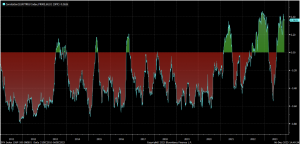In this week’s Asset Allocation team observatory, Moneyfarm’s Chief Investment Officer, Richard Flax, offers some thoughts ahead of US jobs data and some comments on correlations.
A quick round-up ahead of Non-Farm Payrolls
The most recent labour market data from the US supports the idea that economic activity could begin to slow down. According to the US Bureau of Labour Statistics, the number of US job openings was lower than expected. A private sector measure, from ADP, showed that the number of new hires also came in below expectations. And on the cost side, unit labour costs for the third quarter (compared to the previous quarter) also came in lower than expected. All of this is just an appetiser for the non-farm Payroll data that is released on today. Given the drop in yields we’ve seen over the past few days, you’d guess that investors are looking for weaker data from that release as well.
Thinking about correlations
There were several interesting debates ahead of our last rebalance. One question went something like this: we think we should add to longer-duration government bonds, but shouldn’t we add to equities as well? In 2022, we saw equities and bonds fall together. Over the past few weeks, we’ve seen equities and bonds rally together. If we think bonds will rally, maybe equities will too.
For us, this question is really about the correlation between bonds and equities – one of the fundamental tenets of multi-asset investing. The basic idea is that government bonds and equities should be negatively correlated. When growth is strong, equities do well and bond yields rise (anticipating higher inflation), and vice versa. Unfortunately, as we saw in 2022, this isn’t always true.
The chart below illustrates the point. It uses 60-day returns for US equities and US government bonds and shows the correlation of those returns over time. Green shading shows periods of time when bond and equity returns moved together. Red shows periods of time when they didn’t. For much of the past decade, the traditional logic applied and bond/equity returns were negatively correlated. But that hasn’t been the case recently. In 2022 and for parts of 2023, we’ve seen bond and equity returns move together.

So, our latest rebalance – when we bought more government bonds and didn’t add to our equity exposure – contained an assumption about how we see the relationship between bonds and equities over the coming months.
More specifically, we think the US economy could slow down in the coming months, potentially weighing on the outlook for corporate earnings growth and profitability. That scenario could be positive for longer-dated government bonds, but perhaps less positive for equities. That would represent a change from what we’ve seen over the past month or so, when bonds and equities have moved together. If it does work out that way, we think it could create an opportunity for us to add to equity positions in the future.
 Richard Flax: Richard is the Chief Investment Officer at Moneyfarm. He joined the company in 2016. He is responsible for all aspects of portfolio management and portfolio construction. Prior to joining Moneyfarm, Richard worked in London as an equity analyst and portfolio manager at PIMCO and Goldman Sachs Asset Management, and as a fixed income analyst at Fleming Asset Management. Richard began his career in finance in the mid-1990s in the global economics team at Morgan Stanley in New York. He has a BA from Cambridge University in History, an MA from Johns Hopkins University in International Relations and Economics, and an MBA from Columbia University Graduate School of Business. He is a CFA charterholder.
Richard Flax: Richard is the Chief Investment Officer at Moneyfarm. He joined the company in 2016. He is responsible for all aspects of portfolio management and portfolio construction. Prior to joining Moneyfarm, Richard worked in London as an equity analyst and portfolio manager at PIMCO and Goldman Sachs Asset Management, and as a fixed income analyst at Fleming Asset Management. Richard began his career in finance in the mid-1990s in the global economics team at Morgan Stanley in New York. He has a BA from Cambridge University in History, an MA from Johns Hopkins University in International Relations and Economics, and an MBA from Columbia University Graduate School of Business. He is a CFA charterholder.
*As with all investing, financial instruments involve inherent risks, including loss of capital, market fluctuations and liquidity risk. Past performance is no guarantee of future results. It is important to consider your risk tolerance and investment objectives before proceeding.





